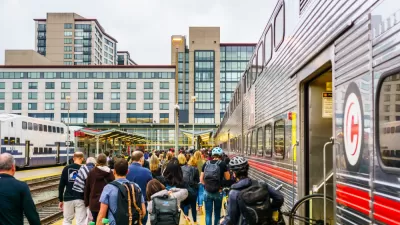An online calculator helps companies determine the broader impacts of their decisions to continue working remotely or return to the office.

Although remote work seems climate-friendly, "the reality is more complicated," writes Sarah Holder in Bloomberg CityLab. A new tool from Watershed Technology Inc. can help companies calculate the environmental impact of returning to the office or letting their employees continue working from home.
Watershed's website explains that, while remote work reduces the energy used in offices, it "shifts carbon: Emissions from energy and food still exist, but at employees’ homes, where they may be better or worse than in the office." Additionally, "a decentralized workforce might lead to more quarterly trips to meet face-to-face," and an exodus to the suburbs could mean increased carbon footprints for more households. The calculator lets companies "assess their greenhouse emissions more holistically, from the power their offices consume to the fuels burned in their supply chain" in order to "measure their impact, make plans to reduce it and make reports on progress."
When it comes to whether remote work is greener than returning to the office, "geography matters," says Holder. "The data analytics company ENGIE Impact suggested that if car commuting is already the status quo for employees at a given office, 'a reduction in commuting is the most reliable way to reduce carbon — even after factoring in the potential for increased energy use in a WFH environment.'" For companies whose employees already relied heavily on public transit, the reduction in carbon will be less impactful. According to Watershed, "the differences between cities are a result of different average household emissions per city, different electricity emissions based on which grid the city is a part of, and the mix of power generation for the grid, as well as average commute distances and respective transport mix for each city."
FULL STORY: The Environmental Implications of the Return to the Office

Maui's Vacation Rental Debate Turns Ugly
Verbal attacks, misinformation campaigns and fistfights plague a high-stakes debate to convert thousands of vacation rentals into long-term housing.

Planetizen Federal Action Tracker
A weekly monitor of how Trump’s orders and actions are impacting planners and planning in America.

San Francisco Suspends Traffic Calming Amidst Record Deaths
Citing “a challenging fiscal landscape,” the city will cease the program on the heels of 42 traffic deaths, including 24 pedestrians.

Opinion: What San Francisco’s Proposed ‘Family Zoning’ Could Really Mean
Mayor Lurie is using ‘family zoning’ to encourage denser development and upzoning — but could the concept actually foster community and more human-scale public spaces?

Jacksonville Launches First Autonomous Transit Shuttle in US
A fleet of 14 fully autonomous vehicles will serve a 3.5-mile downtown Jacksonville route with 12 stops.

‘Big, Beautiful Bill’ Guts EV Tax Credits
The bill eliminates federal subsidies for electric vehicle buyers and charging stations.
Urban Design for Planners 1: Software Tools
This six-course series explores essential urban design concepts using open source software and equips planners with the tools they need to participate fully in the urban design process.
Planning for Universal Design
Learn the tools for implementing Universal Design in planning regulations.
Heyer Gruel & Associates PA
JM Goldson LLC
Custer County Colorado
City of Camden Redevelopment Agency
City of Astoria
Transportation Research & Education Center (TREC) at Portland State University
Jefferson Parish Government
Camden Redevelopment Agency
City of Claremont





























